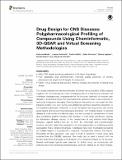Files in this item
Drug design for CNS diseases: polypharmacological profiling of compounds using cheminformatic, 3D-QSAR and virtual screening methodologies
Item metadata
| dc.contributor.author | Nikolic, Katarina | |
| dc.contributor.author | Mavridis, Lazaros | |
| dc.contributor.author | Djikic, Teodora | |
| dc.contributor.author | Vukicevic, Jelica | |
| dc.contributor.author | Agbaba, Danica | |
| dc.contributor.author | Yelekci, Kemel | |
| dc.contributor.author | Mitchell, John B. O. | |
| dc.date.accessioned | 2016-06-14T13:30:05Z | |
| dc.date.available | 2016-06-14T13:30:05Z | |
| dc.date.issued | 2016-06-10 | |
| dc.identifier | 242974165 | |
| dc.identifier | ae1539f6-8352-4d7f-9adb-bcbaa0deb88a | |
| dc.identifier | 84980369116 | |
| dc.identifier | 000377492500002 | |
| dc.identifier.citation | Nikolic , K , Mavridis , L , Djikic , T , Vukicevic , J , Agbaba , D , Yelekci , K & Mitchell , J B O 2016 , ' Drug design for CNS diseases: polypharmacological profiling of compounds using cheminformatic, 3D-QSAR and virtual screening methodologies ' , Frontiers in Neuroscience , vol. 10 , 265 , pp. 18-38 . https://doi.org/10.3389/fnins.2016.00265 | en |
| dc.identifier.issn | 1662-453X | |
| dc.identifier.other | ORCID: /0000-0002-0379-6097/work/34033378 | |
| dc.identifier.uri | https://hdl.handle.net/10023/8979 | |
| dc.description | Support was kindly provided by the EU COST Action CM1103. DA, KN, and JV kindly acknowledge national project number 172033 and OI1612039 supported by the Ministry of the Republic of Serbia. TDj and KY kindly acknowledge "Training in Neurodegeneration, Therapeutics, Intervention and Neurorepair" project number 608381 funded by Marie Skłodowska-Curie action, funding scheme: FP7-MC-ITN | en |
| dc.description.abstract | The diverse cerebral mechanisms implicated in CNS (Central Nervous System) diseases together with the heterogeneous and overlapping nature of phenotypes indicated that multitarget strategies may be appropriate for the improved treatment of complex brain diseases. Understanding how the neurotransmitter systems interact is also important in optimizing therapeutic strategies. Pharmacological intervention on one target will often influence another one, such as the well-established serotonin-dopamine interaction or the dopamine-glutamate interaction. It is now accepted that drug action can involve plural targets and that polypharmacological interaction with multiple targets, to address disease in more subtle and effective ways, is a key concept for development of novel drug candidates against complex CNS diseases. A multi-target therapeutic strategy for Alzheimer`s disease resulted in the development of very effective Multi-Target Designed Ligands (MTDL) that act on both the cholinergic and monoaminergic systems, and also retard the progression of neurodegeneration by inhibiting amyloid aggregation. Many compounds already in databases have been investigated as ligands for multiple targets in drug-discovery programs. A probabilistic method, the Parzen-Rosenblatt Window approach, was used to build a “predictor” model using data collected from the ChEMBL database. The model can be used to predict both the primary pharmaceutical target and off-targets of a compound based on its structure. Several multi-target ligands were selected for further study, as compounds with possible additional beneficial pharmacological activities. Based on all these findings, it is concluded that multipotent ligands targeting AChE/MAO-A/MAO-B and also D1-R/D2-R/5-HT2A-R/H3-R are promising novel drug candidates with improved efficacy and beneficial neuroleptic and procognitive activities in treatment of Alzheimer’s and related neurodegenerative diseases. Structural information for drug targets permits docking and virtual screening and exploration of the molecular determinants of binding, hence facilitating the design of multi-targeted drugs. The crystal structures and models of enzymes of the monoaminergic and cholinergic systems have been used to investigate the structural origins of target selectivity and to identify molecular determinants, in order to direct the development of novel multifunctional ligands. | |
| dc.format.extent | 21 | |
| dc.format.extent | 3910977 | |
| dc.language.iso | eng | |
| dc.relation.ispartof | Frontiers in Neuroscience | en |
| dc.subject | Multi-target drugs | en |
| dc.subject | CNS disease | en |
| dc.subject | QSAR | en |
| dc.subject | Rational drug design | en |
| dc.subject | Cheminformatic | en |
| dc.subject | Virtual screening | en |
| dc.subject | Docking | en |
| dc.subject | QD Chemistry | en |
| dc.subject | NDAS | en |
| dc.subject.lcc | QD | en |
| dc.title | Drug design for CNS diseases: polypharmacological profiling of compounds using cheminformatic, 3D-QSAR and virtual screening methodologies | en |
| dc.type | Journal article | en |
| dc.contributor.institution | University of St Andrews. School of Chemistry | en |
| dc.contributor.institution | University of St Andrews. Biomedical Sciences Research Complex | en |
| dc.contributor.institution | University of St Andrews. EaSTCHEM | en |
| dc.identifier.doi | https://doi.org/10.3389/fnins.2016.00265 | |
| dc.description.status | Peer reviewed | en |
This item appears in the following Collection(s)
Items in the St Andrews Research Repository are protected by copyright, with all rights reserved, unless otherwise indicated.

